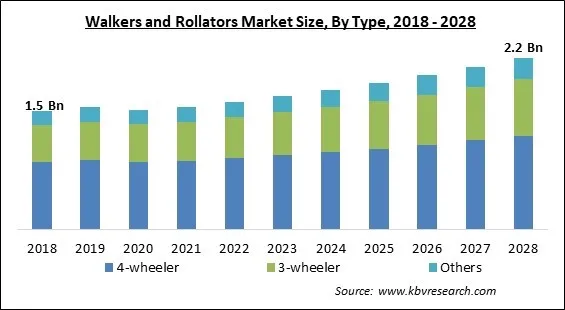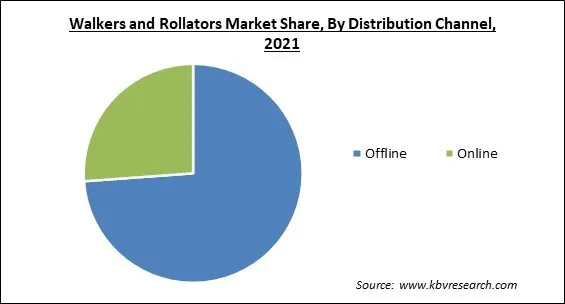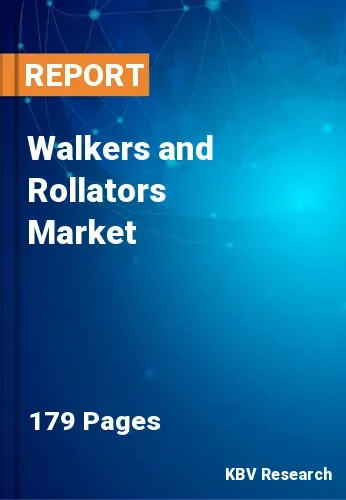The Global Walkers and Rollators Market size is expected to reach $2.2 billion by 2028, rising at a market growth of 5.1% CAGR during the forecast period.
A person uses walkers as mobility aid to assist them in walking. On the other hand, rollators are made for those who can't get out of their chair or bed but still need assistance moving around. It has two handles at the front that can be raised and lowered and four wheels. People who require assistance can use walkers and rollators to get it.

As they assist with balance, stability, and walking, these mobility aids can make it easier for individuals to get around. They come in a variety of sizes and designs, from the classic walkers with three legs or wheels to the rollators with two grips up front that allow users to go forward without bending down too much.
A walker, which is available with or without wheels, is a dependable mobility aid. With non-wheeled walkers, individuals with balance difficulties can support themselves stably. Wheeled walkers have two front wheels, that increase their mobility and ease of movement in addition to provide support. In comparison to a walker, a rollator is a wheelchair with three or four wheels that provides more stability and mobility.
A traditional four-wheeled rollator gives stability and simple mobility, whereas a three-wheeled rollator fits in tighter places, can make fast bends, and has greater maneuverability. There are three varieties of walkers and rollators. No matter if they have a wheel or not, all walkers fall under category 1. Rollators of type 2 have smaller, 4- to 6-inch wheels and are intended for indoor use. Rollators of type 3 have larger, 8-inch wheels that provide greater movement, a seat, and larger wheels.
The rollator includes a hydraulic mechanism that enables the user to move forward by moving a hand crank while still simulating the motion of walking. A rollator is the greatest alternative for people who find it difficult or dangerous to travel long distances alone. Rollators are available in a range of sizes and shapes to suit the user's demands.
The pandemic had an impact on container shipping costs as well as the general logistics and delivery of mobility aids and personal care products. The business's liquidity and finances were significantly impacted by the rising costs of supply chain and logistics. Hospitals prioritized treating COVID-19 patients during the COVID-19 pandemic and avoided treating other patients. As a result, fewer people are being treated for other disorders, including Parkinson's and arthritis. The sale of walkers and rollators has decreased as a result. Throughout the anticipated period, these variables had a negative impact on the market growth for walkers and rollators.
There has been a visible increase in the number of patients with aberrant walking during the past few years. This trend has been noticeable. This can be brought on by issues that are passed down through families, traumatic experiences, or illnesses such as arthritis and gait disorders. People who have these anomalies walk in a peculiar manner since the condition may affect the whole leg or only a portion of the lower limb, such as the ankle or the knee. This can cause the condition to cause atypical gait. Both may be negatively impacted by these abnormalities. People are deciding to employ mobility devices such as rollators in order to navigate around these challenges and enjoy an overall improved quality of life. This will accelerate market growth.
Common health issues that elderly people face include back & neck pain, cataracts and refractive errors, osteoarthritis, and others. As people grow old, they are more expected to undergo various illnesses simultaneously. Elderly people are more at a risk of suffering from severe injuries that might need surgeries. Due to this, the number of surgeries being performed will further grow the need for walkers and rollators with the increasing number of elderly people worldwide.
The stigma of having a "devalued identity" as a result of using assistive technology like walkers is one of the reasons why some older individuals choose not to use it. An older adult who is considering adopting assistive technology, such as walkers, must contend with the possibility of stigma from those who might perceive the walker as an indication of their advanced age and disability. They might be spoken down to, treated as having less mental capacity, and excluded from particular activities. Many older individuals' behaviors are influenced by the widespread perception that being a "old person" is undesirable. The stigma of using walkers & rollators become an obstacle to the growth of the walkers and rollators market.
Based on type, the walkers and rollators market is segmented into 4-wheeler rollators & walkers, 3-wheeler rollators & walkers and others. In 2021, the 4-wheeler rollators & walkers segment dominated the walkers and rollators market with the maximum revenue share. This is credited to the benefits of 4-wheeler rollators & walkers, as they offer more stability and support than 3-wheeler rollators & walkers. In addition, 4-wheel rollators & walkers could accommodate higher weight capacities and a broader range of heights than the 3-wheel rollators & walkers. These factors will support the market growth in this segment.

On the basis of application, the walkers and rollators market is fragmented into 65 to 80 years old, above 80 years old and young. In 2021, the 65 to 85 years old segment held the largest revenue share in the walkers and rollators market. This could be credited to the factor that elderly people are very prone to falling due to less stability of their bodies. These falls could lead to pelvis, hip, spine, and femur fractures, thus obstructing a person's walking and physical mobility. These factors would surge the demand for walkers and rollators among elderly people.
By distribution channel, the walkers and rollators market is divided into online and offline. In 2021, the online segment recorded a promising growth rate in the walkers and rollators market. Rapid development in the e-commerce segment and stimulating the growth of the walkers and rollators with various online channels create opportunities for the upcoming years. People prefer to buy walkers and rollators through these channels due to discounts offers, and less market prices in online stores.
| Report Attribute | Details |
|---|---|
| Market size value in 2021 | USD 1.5 Billion |
| Market size forecast in 2028 | USD 2.2 Billion |
| Base Year | 2021 |
| Historical Period | 2018 to 2020 |
| Forecast Period | 2022 to 2028 |
| Revenue Growth Rate | CAGR of 5.1% from 2022 to 2028 |
| Number of Pages | 179 |
| Number of Tables | 340 |
| Report coverage | Market Trends, Revenue Estimation and Forecast, Segmentation Analysis, Regional and Country Breakdown, Companies Strategic Developments, Company Profiling |
| Segments covered | Type, Application, Distribution Channel, Region |
| Country scope | US, Canada, Mexico, Germany, UK, France, Russia, Spain, Italy, China, Japan, India, South Korea, Singapore, Malaysia, Brazil, Argentina, UAE, Saudi Arabia, South Africa, Nigeria |
| Growth Drivers |
|
| Restraints |
|
Region-wise, the walkers and rollators market is analysed across North America, Europe, Asia Pacific and LAMEA. In 2021, the North America region dominated the walkers and rollators market with the maximum revenue share. Advanced healthcare infrastructure, a high proportion of elderly people, and favorable government policies are some elements that are contributing to the growth of the walkers and rollators market. In addition, the market is growing due to the robust expansion of the healthcare sector in North American nations.
Free Valuable Insights: Global Walkers and Rollators Market size to reach USD 2.2 Billion by 2028
The market research report covers the analysis of key stake holders of the market. Key companies profiled in the report include Eurovema Mobility AB (Weland AB), Karman Healthcare, Inc., Drive DeVilbiss Healthcare (Medical Depot, Inc.), Compass Health Brands Corporation, Human Care HC AB, Invacare Corporation, GF Health Products, Inc., Evolution Technologies Inc., Benmor Medical Ltd., and Briggs Healthcare Corporation.
By Type
By Distribution Channel
By Application
By Geography


The global Walkers and Rollators Market size is expected to reach $2.2 billion by 2028.
Rising cases of arthritis & gait irregularities across the globe are driving the market in coming years, however, Stigma of using walkers & rollators restraints the growth of the market.
Eurovema Mobility AB (Weland AB), Karman Healthcare, Inc., Drive DeVilbiss Healthcare (Medical Depot, Inc.), Compass Health Brands Corporation, Human Care HC AB, Invacare Corporation, GF Health Products, Inc., Evolution Technologies Inc., Benmor Medical Ltd., and Briggs Healthcare Corporation.
The expected CAGR of the Walkers and Rollators Market is 5.1% from 2022 to 2028.
The Offline segment acquired maximum revenue share in the Global Walkers and Rollators Market by Distribution Channel in 2021 thereby, achieving a market value of $1.6 billion by 2028.
The North America market dominated the Global Walkers and Rollators Market by Region in 2021, and would continue to be a dominant market till 2028; thereby, achieving a market value of $747.3 Million by 2028.
Our team of dedicated experts can provide you with attractive expansion opportunities for your business.

